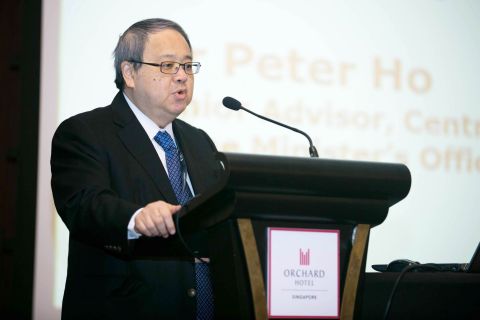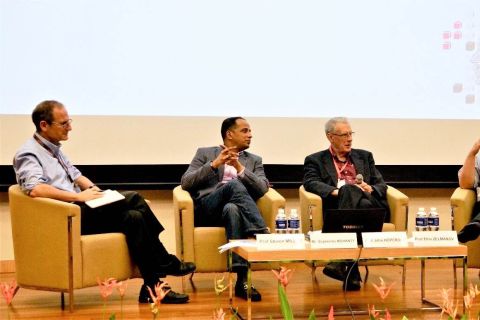
Above (from left): Professor Arnoud De Meyer (moderator), Professor Ada Yonath, Professor François Englert, Professor Gerard ’t Hooft, Professor Stuart Parkin.
By Jeremy Chan
SMU Office of Research & Tech Transfer – Think back on the time before the internet and the world wide web were invented. Go back a little further in time and imagine a world without light bulbs. Were it not for science, engineering and technology, information would not be freely available across the globe, and we would still be reading by candlelight. Science is undoubtedly a benefactor of society, and continues to drive progress today.
But as much as science (including engineering and technology) can be credited for advancing society, the inverse relationship is also true – society has funded science and given it problems to solve, lauding discovery and rewarding innovation. A symbiosis thus exists between the two, but as this relationship becomes increasingly complex over time, scientists have sometimes found themselves at odds with certain stakeholders in society, such as the media, politicians and even the general public.
It was against this backdrop that Professor Arnoud De Meyer, president of Singapore Management University, introduced a panel of eminent speakers for a discussion on ‘Science and Society’ at the Global Young Scientist Summit 2018. The panel was organised by the National Research Foundation and held on 23 January 2018 at Nanyang Technological University, Singapore.
At the panel discussion, Millennium Technology Prize winner Professor Stuart Parkin and Nobel laureates Professor Ada Yonath (Chemistry, 2009), Professor François Englert (Physics, 2013) and Professor Gerard ’t Hooft (Physics, 1999), offered their perspectives on how scientists can better navigate this complex interface with society.
Confronting ignorance
From agriculture and industry to transport and healthcare, science is embedded in virtually every aspect of modern living. But just as one can enjoy a meal without knowing where its ingredients are sourced from, or how the dish is prepared, people are often unfamiliar with the science that underpins common objects they use in daily life, said the speakers.
“People are aware of the results of science but often have little clue about the underlying scientific concepts,” noted Professor Englert, citing the ubiquitous mobile phone as an example.
This sentiment was echoed by Professor Parkin, who felt that society adapts remarkably quickly to new technology despite not knowing how the technology works. On less tangible frontiers of science, such as climate change and artificial intelligence, society may therefore have “unscientific beliefs” associated with this lack of knowledge, and this can be a problem, he said.
“The other problem is unpredictability – much of science deals with large, non-linear systems, whereby you don’t have a complete idea of the state of the system, so you cannot make a prediction, or you make a wrong prediction that’s based on the available evidence,” said Professor Parkin. Hence, when more evidence comes to light and the scientific consensus changes, laypersons find it difficult to accept that change and continue to hold on to older ideas, added Professor Parkin.
Here, scientists have an important role to play, said Professor ’t Hooft. “We [as scientists] have a responsibility to communicate findings that are more precise, including our lack of certainty… to people who want to include scientific knowledge and findings in their general belief of how the world works,” he said.
Bridging minds
But the communication of science comes with its own set of difficulties. Science comprises a multitude of disciplines, each with its own complexities and jargon. This poses a significant barrier to the understanding of science by the general public, which may hinder dialogue between scientists and the rest of society.
“Society has opinions and comments on a whole range of issues, be it music, sports or politics, but when it comes to science, the conversation flows less readily,” Professor Yonath noted. Both she and Professor Englert agreed that there was a need to improve the public’s general scientific literacy, and to overhaul the way the sciences are taught in schools.
“The borders between chemistry, biology and physics are not as clear now as they were 200 years ago, but the teaching [of science in terms of clearly defined disciplines] is as it was then. I think we have to teach borderless science according to processes, and in a problem-oriented manner,” said Professor Yonath. She gave the example of doing laundry, where biological contaminants such as dirt and bacteria are removed by chemicals in detergents, then dried by the physics of heat and wind. Thus, in a single process, multiple scientific concepts can be introduced and explored.
Beyond education, the media also has a role to play in encouraging scientific literacy among laypersons. To this end, Professor ’t Hooft thinks that mainstream media channels should be leveraged for their entertainment value. He suggested that if quizzes, game shows and documentaries could do more to touch on science topics in an accessible manner, that could go a long way in making science more palatable to the public, he said.
Expanding on this point, Professor De Meyer said: “While good media can be useful, we have so many different platforms—iTunes, YouTube or TED talks, for example—that we [as scientists] can use to communicate our research directly to the public.”
But more than just conveying facts and findings, “the one thing that we can hope to transmit to society is that science is an approach to knowledge… it is a passionate way to understand the world,” said Professor Englert.
Getting priorities right
While education and the communication of science are important, ensuring the continuity of the knowledge-seeking enterprise is equally critical, said the panel. A large proportion of a country's research and development is funded by its government; hence, funding priorities and research agendas can sometimes change along with political parties.
“The danger of mixing politics and science is that in many situations, politicians by necessity, are focused on short-term issues. But to have true development of science, including the applications and techniques that you want to get out of it, you have to focus on long-term effects,” said Professor Englert.
Because of these differences in priorities, curiosity-driven science, also known as blue-sky research, is sometimes sacrificed in the interests of translatable research with clearly defined application goals. Result-oriented science encourages young scientists to count publications and patents rather than seek a true understanding of natural phenomena, and may also compromise the integrity of the research, said Professor Yonath.
Professor De Meyer also acknowledged the “natural tension” that exists between long-term scientific goals and short-term barometers of research performance or return on investment. “It is important to manage this tension, and while doing so, we need to keep on doing basic research and not only translational research,” he said.
“Maybe [curiosity-driven science] will only be useful two to three generations later, but in the meantime, the creation of deep knowledge and understanding is much more important than profit value,” she concluded.
Back to Research@SMU Issue 52
See More News
Want to see more of SMU Research?
Sign up for Research@SMU e-newslettter to know more about our research and research-related events!
If you would like to remove yourself from all our mailing list, please visit https://eservices.smu.edu.sg/internet/DNC/Default.aspx

